Physical Address
304 North Cardinal St.
Dorchester Center, MA 02124
Autologous fat is an ideal filler that provides patients with long-lasting revolumization. With proper patient assessment, planning, and treatment, facial augmentation provides a safe means to restore the youthful contours of the face. The use of autologous nanofat, microfat, and stromal vascular fraction in small grafts placed strategically throughout the soft tissue planes of the face stimulates ongoing regeneration of facial texture, volume, and contour.
Indications for Autologous Fat Transfer (AFT).
Patient selection.
Pre-operative assessment and planning.
Fat harvesting techniques.
Graft preparation.
Graft placement.
Postoperative considerations and complications.
Autologous fat is an ideal filler for facial rejuvenation as it is relatively abundant and easy to obtain, immunologically compatible, and longer lasting than the available bioengineered injectable products. Autologous fat transfer (AFT) is regarded as an elegant technique to correct volume deficits and aging of the face. It allows for a minimally invasive restoration of soft tissue contour and facial atrophy with precise titration and placement of the patient’s own fat. Soft tissue volume loss can result from trauma, scarring, post tumor extirpation, chronic wounds, HIV lipodystrophy, and congenital anomalies. However, the most common cause of soft tissue and bony volume loss in the face is the natural aging process. Facial aging is a multifaceted and dynamic process in which all the structures of facial anatomy play a role. The subcutaneous fat of the face is partitioned into discrete anatomic compartments, and these fat compartments carry variable propensities for age-related volume loss. Additionally, gradual changes in the thickness and elasticity of skin, decreased adherence between the skin and subcutaneous tissue, sagging of the soft tissues, weakening of the facial muscles, and the progressive decrease in the volume of the craniofacial skeleton all contribute to the natural aging process. AFT is a nonimmunogenic and safe means to address facial volume loss.
Although fat grafting is an old technique that can be dated to as early as 1893, it has gained increasing popularity for use in facial and cosmetic surgery. Since the advent of liposuction, adipose tissue is easily obtainable in substantial quantities and yields significant amounts of multipotent cells to be used for transplantation. Harvesting and preparation of fat grafts do not require cell culture and can be performed in-office on the same day as grafting, making the procedure clinically feasible for both patients and physicians.
Since the discovery of adipose-derived stem cells in 2001, there has been increasing research into the clinical applications of these multipotent mesenchymal-derived progenitor cells. Different techniques by which adipose-derived stem cell preparations can be processed, whether as macrofat, microfat, or nanofat, allow for different depths and areas of application within the soft tissue planes of the face. The initial isolated adipose tissue is composed of adipocytes and stromal vascular fraction (SVF) cells, which include adipose stem cells, pre-adipocytes, fibroblasts, vascular endothelial cells, and immune cells. There are now a number of studies and reviews to support the improved survival of fat grafts with the addition of adipose stem cells and SVF cells to enhance survival.
The most important factor for achieving excellent results is appropriate patient selection. As with all aesthetic preoperative consultations, it is important to discuss expectations, timelines, and risks and benefits of AFT. Pre- and postoperative photos from five standard angles should be taken to document and display for the patient the volumetric changes associated with the procedure. These include frontal, bilateral lateral, and bilateral oblique views ( Fig. 12.1 A–C ).
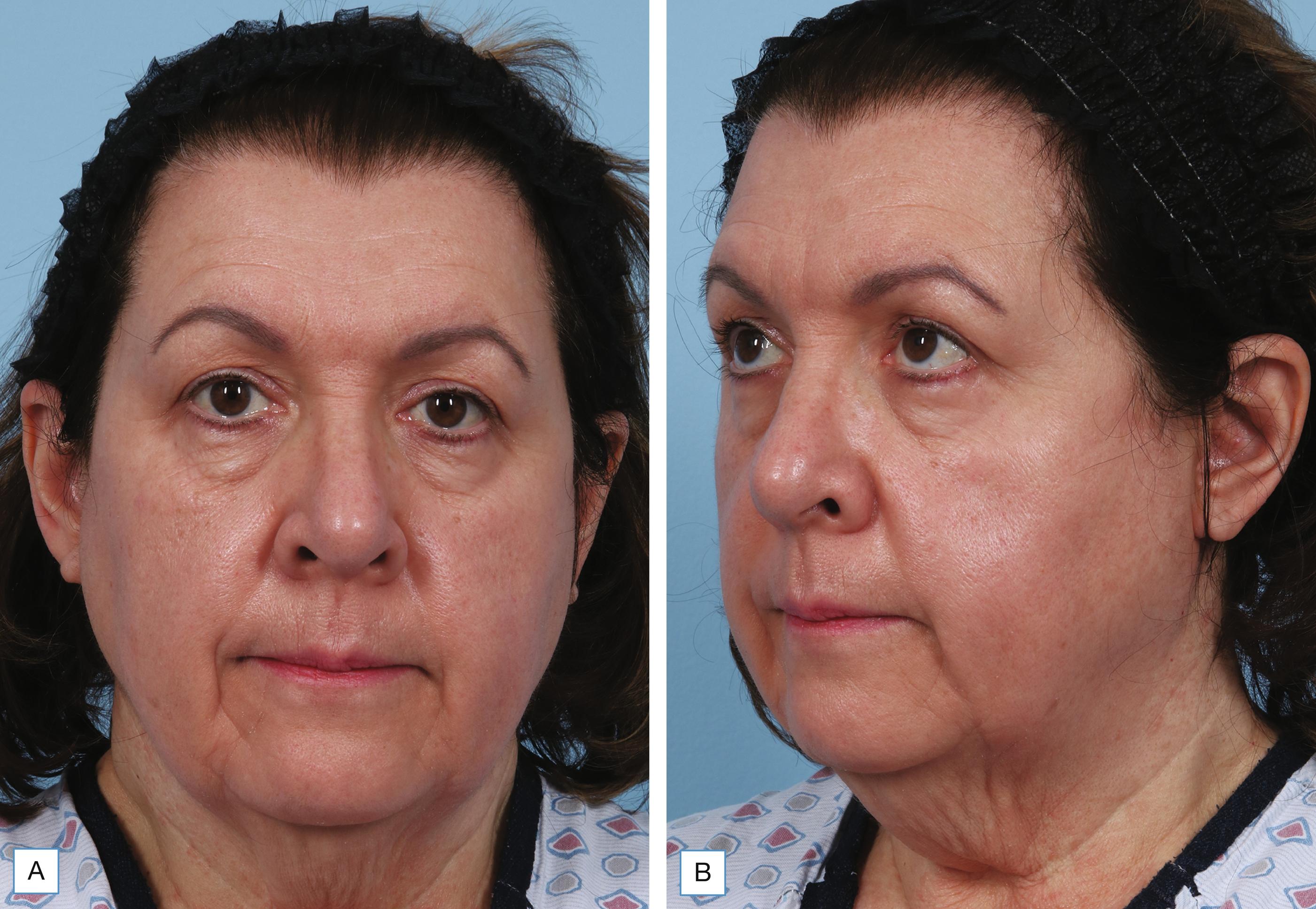
The ideal candidate for AFT should have a sufficient fat volume source as well as facial volume loss (thin face with a normal or elevated body mass index). Patients with a low body mass index will not have sufficient fat stores to harvest for transplantation and their fat is programmed to remain lean even after grafting (not giving a robust change). Additionally, patients should remain at a stable weight, as fluctuations in weight will affect fat grafting outcomes. A 10-pound weight loss will diminish the results, while a 10-pound weight gain may cause the patient to appear overly full. Patients below the age of 60 years tend to have better outcomes and require fewer treatments to achieve the desired results. This is thought to be due to the decreased abundance and plasticity of mature stem cells as patients age. As a rule, fat transfer should not be performed in smokers due to the resultant vasoconstriction that will not support the survival of the fat grafts. A patient should be questioned regarding prior trauma or surgical procedures to avoid harvesting fat grafts from sites of increased fibrosis. For patients with a history of eyelid surgery, especially lower eyelid surgery, there is a risk of prolonged lower eyelid edema following AFT, and patients should be counseled about this risk. The surgeon should also elicit a history of cheek or chin implantation as this will prevent placement of fat grafts at the level of the periosteum in these locations.
Patients undergoing AFT should be in stable medical condition. Any patients requiring anticoagulating agents should consult with cardiology or hematology prior to stopping these medications so as to avoid undue risk of clot formation. Because blood is toxic to the fat grafts, anticoagulation must be stopped prior to fat grafting and can be restarted only once an appropriate amount of time has passed postoperatively. Patients are advised to avoid/discontinue aspirin, nonsteroidal anti-inflammatory medications, fish oil, vitamin E, and herbal supplements 2 weeks before and 1 week following treatment. The senior author (SO) recommends supplementation with bromelain 500 mg twice a day on an empty stomach starting 1 week prior to surgery and continued for 1 week postoperatively to help reduce postoperative swelling and bruising.
Patients should be counseled regarding the need for appropriate social and physical downtime. AFT performed under local and tumescent anesthesia, with proper avoidance of blood thinning medications and supplements, usually results in a 7- to 8-day recovery. The risks of AFT include infection, bleeding, vascular occlusion, necrosis, fat cysts, granulomas, and, in rare cases, blindness. Prophylactic antibiotics are not recommended unless the patient has orthopedic or cardiac conditions necessitating prophylaxis.
Selection of the appropriate anatomic area for adipocyte harvesting should be based upon the body habitus of the patient as well as history of previous surgery or trauma. Reviews of AFT have failed to show significant differences in adipocyte survival based upon harvest site. 7 However, most surgeons agree that the ideal harvest site is the outer thigh, due to increased levels of mesenchymal cells and collagen. This area is followed by the flanks and the abdomen in order of preference. However, liposuction within areas of prior surgery should always be avoided, as these sites tend to yield a more bloody or fractured aspirate. The site must have both adequate surface area and subcutaneous thickness as measured by the palm and pinch test to allow for sufficient quantity of fat to be harvested. A palm size area (∼ 200 cm 2 ) with a pinch thickness of at least 0.25 cm allows for approximately 50 mL of fat graft. 12 The approximate quantity of fat available for harvest at the donor site should be calculated and checked against the fat volume needed for revolumization. Oftentimes, patients have asymmetry of fat on their thighs or flanks; thus, the harvesting process can be used to give a secondary benefit by making the patient more symmetric by removing more fat from the fuller area.
The harvesting site should be marked and prepared with betadine ( Fig. 12.2 A ). Incision points should be anesthetized with 1% lidocaine with epinephrine, and stab incisions can be made with a No. 15 blade. Tumescent anesthesia consisting of 0.2% tumescent anesthesia solution with 1:500,000 epinephrine should be injected through these incision sites into the donor site. The tumescent solution is administered with a 2-mm infiltrating cannula and a 20-mL syringe in a fanning technique.
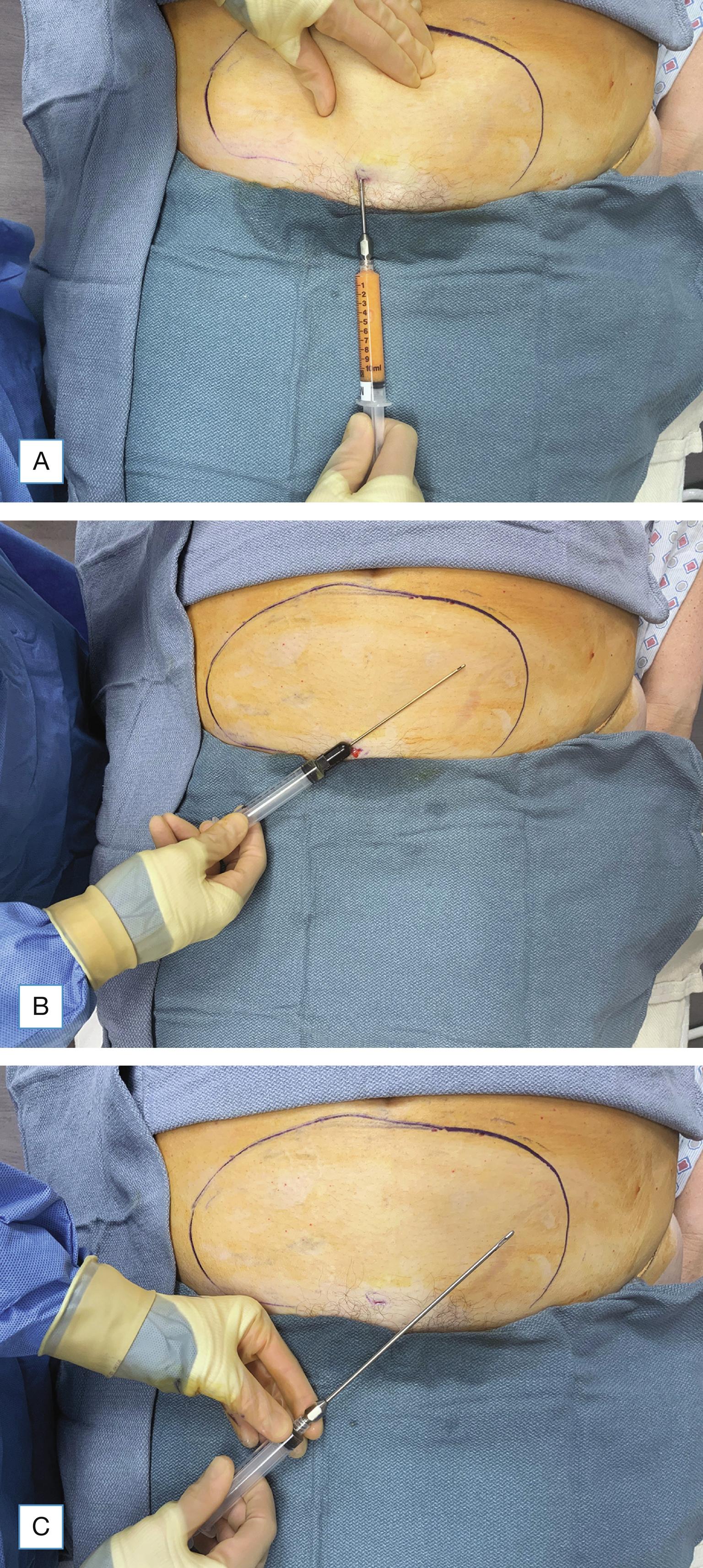
A 10-ml syringe is used for the fat harvesting. Prior to harvesting the fat, 1 mL of 25% albumin (Baxter Pharmaceuticals, Deerfield, IL) should be placed in the syringes to concentrate the fat and restore oncotic pressure. The nanofat should be harvested using a 14-g Carraway Harvester Cannula (Tulip Medical Products, San Diego, CA) ( Fig. 12.2 B). To harvest the microfat and macrofat grafts, a Byron accelerator cannula (Mentor, Irvine, CA) is used ( Fig. 12.2 C). Manual suction with 1 to 2 mL suction (< 6 mm Hg) should be used so as to avoid damage to the grafts. Using a gentle, fanning motion, the fat should be gradually collected in the syringes. The filled syringes are inverted and left to decant while the other syringes are filled. Infranatant fluid is expelled and the syringes are topped off again with fat. The incision sites are left open to drain and to heal by secondary intent.
Harvested fat should be centrifuged using a closed system or sterile rotors at no higher than 3000 RPM for about 30 to 60 seconds ( Fig. 12.3 ). This allows for adequate separation of purified fat, concentrated growth factors, and adipose-derived stem cells beneficial to graft retention, while preventing overconcentration and rupture of fat cells. The supernatant is made up of ruptured fat cells and oil and should be wicked from the syringe ( Fig. 12.4 ) using a sterile telfa pad strip or sterile dental rolls. The central part of the centrifuged product is made up of viable adipocytes, stem cells, and growth factors, which will become the fat graft. The infranatant is made up of fluid and can be easily drained from the bottom of the syringe.
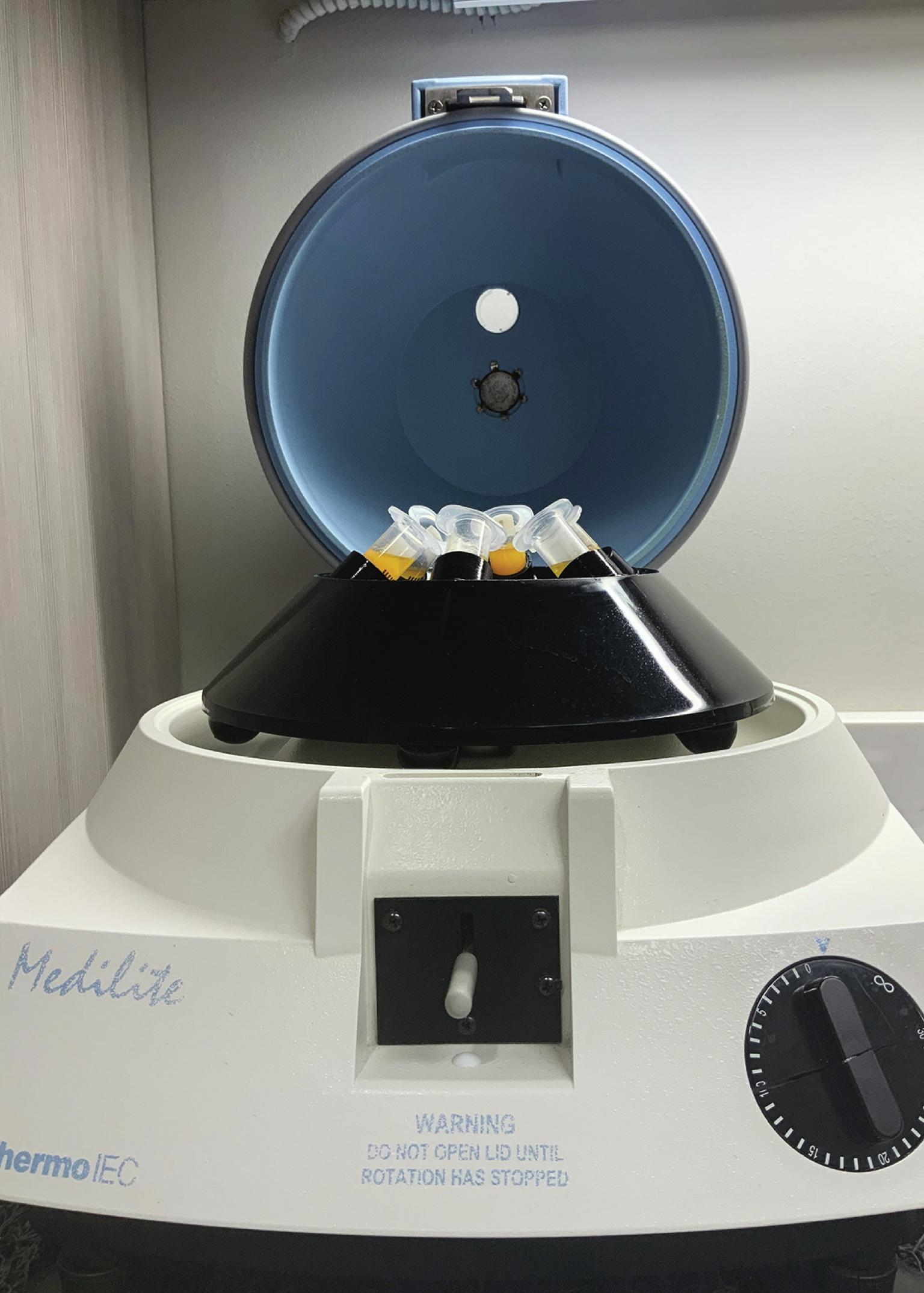
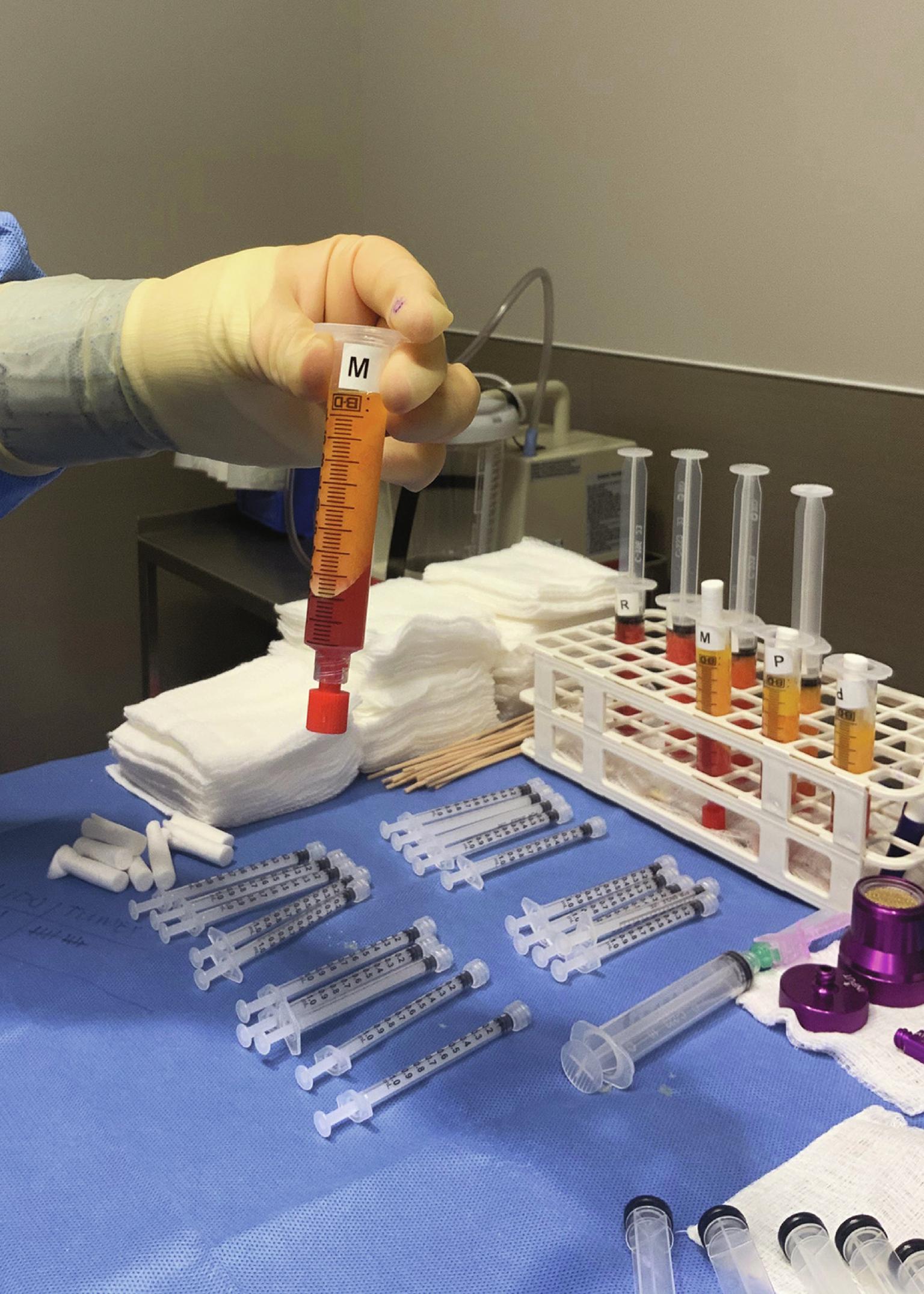
Nanofat is also referred to as “tissue SVF” (tSVF) in different scientific articles. It implies a mixture of adipocyte-derived stem cells and extracellular matrix cells. To create the nanofat, the fat that was harvested through the Tulip cannula should be micronized and emulsified further. Mechanical processing of nanofat for isolation of adipocyte derived mesenchymal stem cells (AD-MSCs) is performed using the Tulip nanofat system (Tulip Medical Products). First, the fat is passed back and forth through a 2.4-mm luer lock for a total of 20 to 30 passes, followed by a 1.2-mm luer lock for another 20 to 30 passes ( Fig. 12.5 ). The fat will then be pushed through an autologous cellular matrix (ACM) device to filter out the stroma and mature adipocytes while allowing the stem cells to pass through. The micronized fat is pushed through the ACM filter and collected in a syringe with the patient’s platelet-rich plasma (PRP). The nanofat will be used in areas of thinner skin to enhance the texture of the skin. Nanofat is not used to volumize an area.
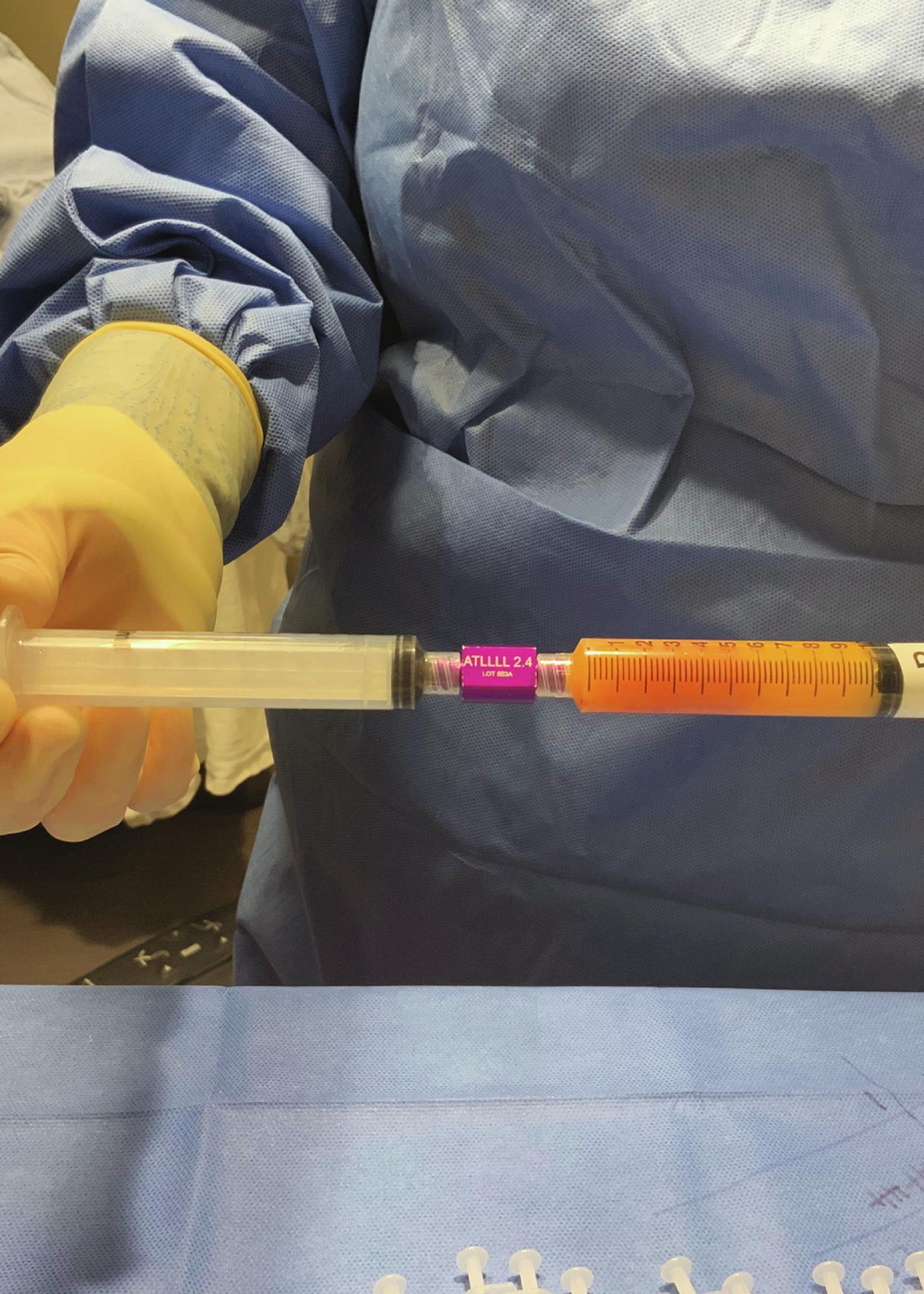
Approximately 1 mL of nanofat or SVF will be added to 9 mL of regular and microfat grafts for stem cell enhancement. Once the fat grafts have been prepared, they should be transferred to 1-mL syringes for injection ( Fig. 12.6 ).
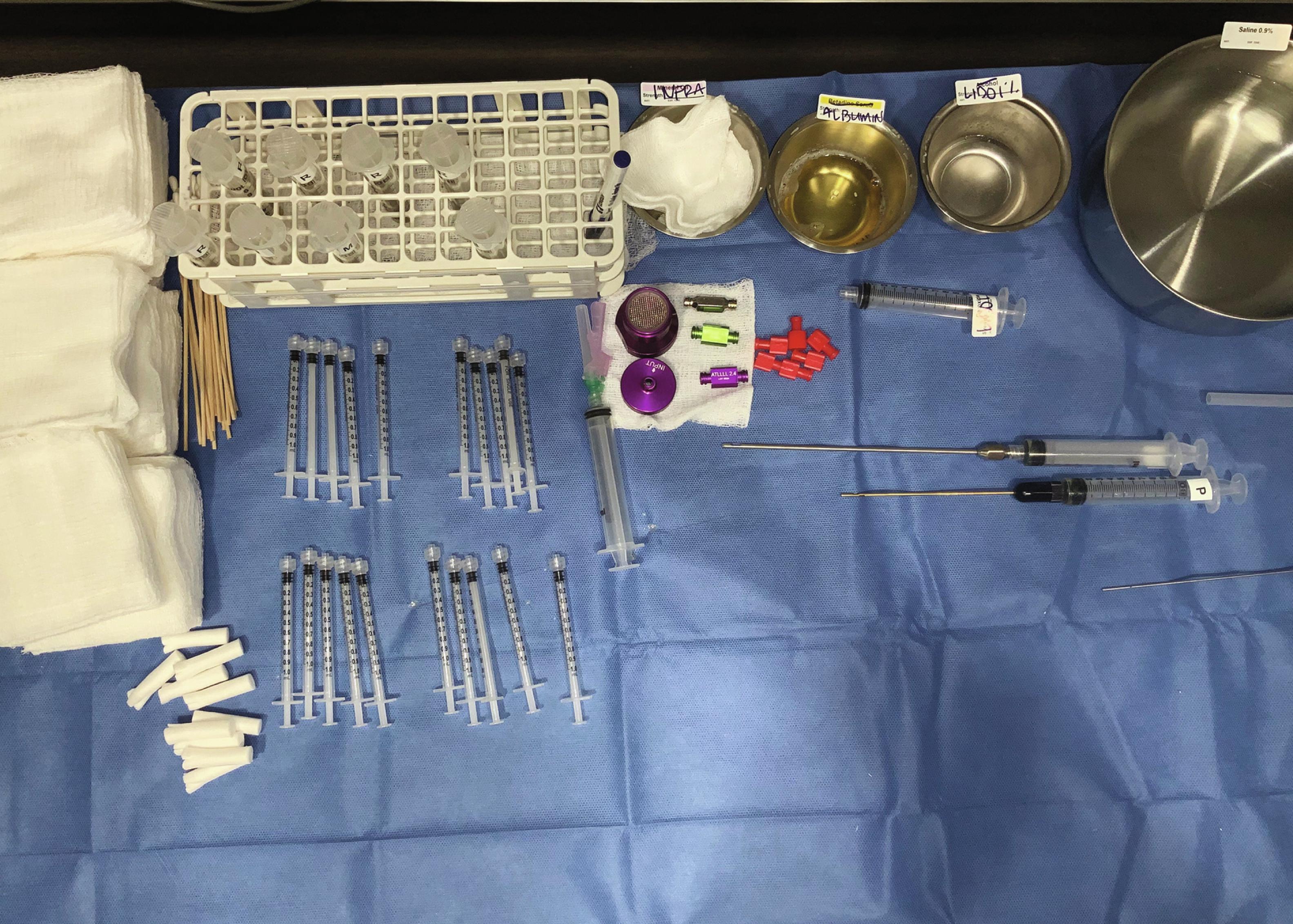
Become a Clinical Tree membership for Full access and enjoy Unlimited articles
If you are a member. Log in here